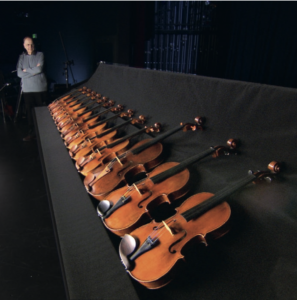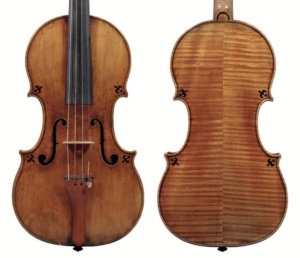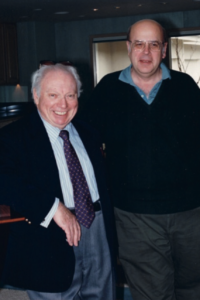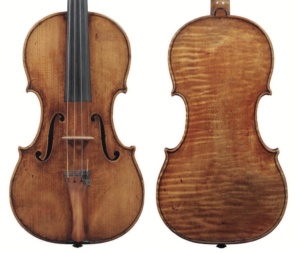David Fulton, arguably the world’s most important living collector of violins, has just written a new memoir, The Fulton Collection: A Guided Tour. A few weeks ago, Dave and I spoke by Zoom about his advice on collecting, shifts in the business, and the instruments that changed his life. Dave’s new memoire can be purchased at davidfultoncollection.com/book

Jason Price: Hi, Dave. Nice to see you! Thank you for taking the time to speak with me.
David Fulton: Good morning. It’s my pleasure.
JP: You have just finished writing a mammoth book, a real tour de force. It’s over 450 pages and it’s unlike anything I’ve ever seen before in fiddle literature. It’s very impressive.
DF: Thank you. That’s very kind of you to say. I hope it’ll be useful too: the thing weighs three kilograms. So if a burglar comes into your house, you can throw it at him.
JP: Ha. Well, really, it’s filled with many surprises that are interesting to fiddle nerds like us. For instance, you talk a lot about the other great violin collectors of the past. But you know what, you’ve actually been collecting for longer than most of them. The Baron Knoop did it for 30 years. Richard Bennett has you beat by a little, but only just, and you can still beat him. You’ve been doing this for 40 years. What kept you going?
DF: Yes, I’ve been doing it for 40 years. It’s been a passion of mine. And I suppose it’s one way of getting close to being a real violinist; I’ve met most of the great ones.
JP: Your book tells the stories of the 28 instruments you owned – seven Strads, seven Guarneris – including the ‘Pucelle,’ the ‘General Kyd,’ the ‘Baron Knoop,’ the ‘Lord Wilton,’ the ‘King Joseph,’ the ‘Kemp’. These fiddles are icons .
DF: That’s right. Well, it’s been such a joy to have them available to look at and play. They’re such great things you know, I mean, they’re wonderful.
I suppose collecting is one way of getting close to being a real violinist; I’ve met most of the great ones.
JP: Reading your book, I was struck by how much fun you had building this collection. There’s so much joy, so much pleasure, at every step along the way. You tell of that wonderful moment when you and Dr. Sloan had just driven away from Chicago and you pull over at some diner in the middle of nowhere on your way home. And of course you bring the violins with you into the restaurant: you had the newly acquired Peter of Mantua, your first serious violin, and Dr. Sloan at the time had the ‘Holroyd’ Strad. So you bring the violins into the diner and set them on the booth next to you and you crack the cases open a little to look at them, and you just kind of pinch yourself thinking, this is incredible.
DF: I remember that with great fondness. I was talking to Dr. Sloan at his birthday party about that just a few months ago. That’s one of the highlights of both of our lives. Because there we were in a diner in the middle of nowhere, we opened those cases and peeked inside, just like we were looking into the Lost Ark.

Fulton’s first important violin, a 1698 Pietro Guarneri of Mantua.
JP: You said something really interesting that stuck with me. You said that in the beginning, all collectors are naïve and a bit stupid. And I thought, that’s a really profound thing to say from someone who’s put together one of the best collections of all time. What did you mean by that?
DF: In the beginning you don’t know what you should be collecting. You need good guidance. What I mean by being naïve and stupid is that nobody knows all this stuff going in. You need to find a mentor, and to find people you can trust.
JP: I noticed that in the book you tell us the prices you paid for these instruments, but you don’t tell us the prices that you sold them for. I mean, it’s fascinating to look back at prices from 20-30 years ago and think “I’ll take 10 of those.” But on a serious note, what do you think of the escalation of prices that you’ve seen over the 40 years that you’ve been collecting fiddles?
DF: You know, violin prices have gone up more or less like house prices. Over these 40 years the increase on my little Peter of Mantua, for example, was about seven and a half percent per year. So it’s not a bonanza. For the whole collection, viewed as money paid versus money received, the internal rate of return over 40 years was about five and a half percent.
JP: So, like you said, it’s not a bonanza, but it is an excellent strong, slow-steady-growth proposition.
DF: That’s right. On the other hand, anyone that gets into fiddles as an investment, better do it because they’re also in love with them. Because the fact is, you can’t always sell them quickly, it takes strategy and lots of time. You know, if you’re riding a tiger, you’d better take care how you dismount.
You know, if you’re riding a tiger, you’d better take care how you dismount.
JP: Ah ha, good point: the exit strategy is just as important – if not more important – than the acquisition.
DF: Yes. I mean, they’re a very safe investment. And as I noted in the book, for example, many musicians were able to start new lives after fleeing from Nazi Germany, because of the instruments they took with them. But unfortunately, life is finite. I’m in good health and all that. But the last thing in the world I would want to do is to leave these instruments for my kids to deal with.
JP: In your book, you give us the impression that when you set your sights on a fiddle, you got it. Maybe it took a couple years, and maybe it had to work its way through a process or someone had to be at the right stage of their life that they were ready to sell it to you, but the impression you give in the book is that if you wanted something, you got it and that’s how you put together a collection of this level.
DF: Well, not entirely. There were a few that got away. I made one great mistake and that was not buying the ‘Muntz’ Stradivari when I had a chance to. The ‘Muntz’ is something that causes me to choke up talking about it because it’s one of Stradivari’s last violins. The purfling is kind of shaky and the instrument is a bit cockeyed: one f-hole is noticeably higher than the other. But it’s a great violin. The old man was 92 years old and he could still do it. It was a big mistake not buying that when it was offered to me. And the other one that got away was the Macdonald viola. Charles Beare and I took a run at it on three occasions. It belonged to Peter Schidlof, the violist in the Amadeus quartet. After he died we made an offer on the viola, I think maybe 16 million or something like that. But the widow felt very sentimental about it and didn’t want to sell it. Then a few years later, we tried again. And the family said no, we can’t sell it. I think we offered 18 million that time. The third time we took a run at it they said, “Well, we just don’t want to sell it.” And then some years later I got a call from one of the London dealers and he said the viola is now for sale, if you want to buy it, you can buy it for $45 million. I said, “Well, I hope you get that. But you’re not going to get it from me!”
JP: Smart move.
DF: So I’ve never had a Strad viola and I never will have a Strad viola. Baron Knoop had three Strad quartets. No one had ever done that before and no one will ever do it again.
JP: But you had a Guarneri quartet… Not many people put that together.
DF: Yeah, but not all the same Guarneri of course. But that’s alright.
In the beginning, all collectors are naïve and a bit stupid.
JP: In your book you talk a lot about the Great Violin Database that you created and it occurred to me that over the course of your career, two major technological changes happened in the violin business and both of them, I think, are very important to you personally and professionally. The first was the renaissance in digital photography that has changed the way we document instruments. And the second is the importance of databases in storing provenance and tracking fiddles through history. You built one of the earliest consumer database systems, FoxPro, which eventually developed into MS Access after it was purchased by Microsoft.
DF: Right, well, I think it’s terribly important that historical information should eventually be public. And as you saw, there are many entries from the diaries of Arthur Hill in my book that all come out of the Great Violin Database. And aren’t those diary entries fascinating? I think they greatly illuminate the whole situation… Your Cozio site is marvelous. You know, they once asked me ten years ago if I’d care to take that over.
JP: Is the offer still open? Can we please take you up on that?
DF: I’m retired!
JP: I wish… That would be amazing: “David Fulton curates the Cozio Archive.” Amazing …
I loved your chapter on Isaac Stern. As you know, Tarisio cut its teeth on the 2003 auction of the collection of Isaac Stern. Obviously, you were seeing it from a different perspective, because you were his friend, you bought the Panette from him and you almost bought the Ysaye from him.
DF: Stern was a unique character. And that’s why the longest chapter in the book is the one about Isaac, because he was sort of a friend … kind of. Although, as I said, I think he may have viewed my friendship more like the way a rancher feels about a prized steer: Isaac always wanted something or another. He was quite a character and I spent some very interesting time with him.

Isaac Stern with an “undistinguished pupil” according to Fulton’s memoire.
Anyone that gets into fiddles as an investment, better do it because they’re also in love with them.
JP: You said something very funny about Isaac. He had surprised you one morning early when you were practicing. He sort of snuck up and eavesdropped on you. Then you ended up getting an hour-long lesson out of it.
DF: True, I got a lesson from Isaac Stern but I’m certainly the least of his pupils.
JP: Ha, that’s really funny, I have a similar story myself. During my freshman year in college I had a piano trio. I was an English major but I was still somewhat serious about the cello. We had this trio but we weren’t really all that good. Well, Isaac Stern came to the college one day to give master classes. He let my piano trio get halfway through the first page of the Brahms B-major trio and then he stopped us, nodded slowly and said, “Listen… tell me the truth, you’re not really music majors are you?” That man did not waste words!
And speaking of Isaac’s instruments, in the book you write about Sam Sygmuntowicz’s copy of the ‘Panette’ Guarneri that we sold in the 2003 sale. You owned the original ‘Panette’ and you were bidding on this bench copy that Sam made for Isaac. It sold for $130,000, a record at the time.

The ‘Panette’ Guarneri ‘del Gesù’.
DF: Yes I was there when Sam presented the violin to Isaac at the Metropolitan Museum exhibition that Pete Biddulph put together. So, I was trying to buy it and I was on the phone with Robert Bein who was also bidding.
JP: And Robert was on the phone with me!
DF: How funny… I was going to bid more but Robert said, “You’re done.”
JP: Oh… he didn’t tell me that. That’s not fair(!)
DF: Yes, I was going to bid, perhaps, 140,000 just for sentimental reasons: because I was there when the fiddle was presented to Isaac and I thought it would be a cool knick-knack to have around. And so when I was going to bid a little more Robert said, “You’re done. You don’t need that.”
JP: I think that’s what Robert called “controlling the customer.”
DF: That was his way of doing it.
JP: One last question, Dave: What advice would you give to the next Dave Fulton? No one’s going to be able to replicate your collection but what advice would you give to aspiring collectors of the next generation?
DF: Well, that’s a good question. I guess the main thing is to identify who it is that you can trust. You have to know the people involved and decide who you can trust. You have to study the market and if you can, find a mentor. And the best part about it: if you do it right and if you do it with the right people, it’s a lot of fun; this business is just a lot of fun.
JP: That’s great. Thank you so much, Dave, this has been a real pleasure talking with you. And thank you for writing this book. It’s a special thing.
DF: My great pleasure. Thank you, Jason. I’m so happy that you enjoyed the book. It’s been great chatting.
This interview was edited for clarity and brevity because both of us enjoy this subject way too much and could talk about it forever.
David Fulton’s memoir is available for purchase here.